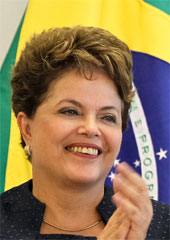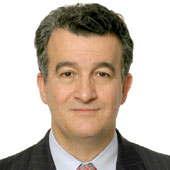Brazil and the Global Battle to Eliminate Extreme Poverty
Is Latin America’s largest country providing a global model for how to reduce poverty in lean budgetary times?
March 26, 2013

Extreme poverty causes enormous human suffering and still afflicts over one in every five people on earth, according to figures by the World Bank. The goal of combating extreme poverty is the bedrock of the entire development community and has been embraced by legions of World Bank presidents.
The institution’s new president, Jim Yong Kim, speaks of the need to “bend the arc of history in order to eliminate extreme poverty and achieve shared prosperity.”
At a time when the World Bank’s resources — as well as the budgetary resources of governments around the world — are more limited than he might wish, Brazil offers important lessons on how to eliminate extreme poverty and reduce inequality.
Perhaps the biggest lesson to be learned from Brazil is that real progress on reducing poverty levels can be achieved in a very cost-effective manner — if the programs pursued are well-targeted.
Brazil is an unlikely success story in that regard. My home country has long been known for having one of the most unequal levels of income distribution on the planet. And it has often been cast as the “country of the future” — a place where the poor rarely saw the benefits of industrialization and economic growth.
This changed when President Lula da Silva was elected in 2002. He ran on a platform not only to boost social and economic inclusion and to fight poverty and inequality — but also to achieve that goal within a single generation.
Building on the economic foundation established under his predecessor, Fernando Henrique Cardoso, Lula’s strategy was not at all aimed at doing the typical politician’s thing — to spend more on social programs.
Instead, Lula — a man who had experienced long bouts of poverty firsthand — made the fight against poverty and inequality the central organizing principle for his entire presidency.
In fact, the government’s other policymaking initiatives were of secondary importance, in the sense that they had to support his main policy plank. At long last, the fight against poverty was not just an add-on, as it so often is, even in very poor countries around the globe.
It is well-known that Lula’s program initially did not receive a warm welcome from the financial markets. They were concerned that his commitment to what they perceived as a utopia would lead him to implement irresponsible, populist and unsustainable policies. They were wrong.
There were plenty of doubters within Brazil itself as well. They were convinced that, after 500 years of a national history marred by exclusion and inequality, bending the arc of history would certainly take far more than a single generation. They, too, were wrong.
By the end of Lula’s two-term mandate, the results were already impressive. Income inequality, measured by the Gini coefficient, had declined sharply — from 0.553 in 2002 to 0.500 in 2011. Household per capita income had increased by 27% — from 2003 to 2011. Unemployment rates fell from 9.1% in 2002 to 6.8% in 2011, a record low.
When President Dilma Rousseff, President Lula’s former chief of staff, was elected as his successor, she upped the ante, running on a platform to eliminate extreme poverty not in a generation, but in just five years.
I know as well as anybody that the world of politics is full of skepticism, if not cynicism. Considering the lofty speeches by endless numbers of politicians declaring big goals (usually without ever intending to meet them or coming close to meeting them), there is good reason for doubt.
And yet, in Brazil’s case, the target of eliminating extreme poverty is surprisingly close to being achieved. The reform agenda’s cornerstone was a determined expansion of the social protection programs by making sure that all poor households in the country would be reached.
The two key programs are, first, the Bolsa Familia (a conditional cash transfer program that increases the incomes of the poorest families while promoting health and education) and, second, the Brasil sem Miséria (an extension of Bolsa Familia aimed at people living in extreme poverty, with elements for inclusion in the productive sector and access to public services). The per capita transfer is currently 70 reais (or $35) a month.
The two programs now reach 100% of all Brazilians that are listed in the national database used to manage and monitor the social programs of the country. At this moment, there still are 700,000 people that live under the poverty line who do not yet receive payments from either of the support programs because they have not been included in the registry.
(Brazil is a continent-sized nation, with a landmass of 8.5 million square kilometers, very close to that of the United States, and a total population of 194 million, the fifth largest in the world. Some of the nation’s extreme poor live in completely isolated areas.)
Most people, when they look at the challenges of economic development, believe that poverty alleviation is a moral obligation — but that it is also expensive and, even if started successfully, may not be sustainable financially. Brazil’s case shows that this does not need to be so.
The cost of Bolsa Familia has been extremely low. In 2012, the program cost the Brazilian government less than 1% of its budget.
On the social front, the results are solid. While much more needs to be done, Brazil has seen a marked decline in violence and an increase in political activism and cultural movements. In many of the urban areas, ambitious programs were launched to “pacify” areas previously associated with drug trafficking and violence.
A key part of the improved urban environment is that the urban poor now have a sense of destiny and direction. They welcome the government’s focus on investment in families’ futures and especially the smart focus on the young and their education.
There is a quiet confidence in the eyes of young children living in the favelas that has never been there before. Without knowing it, they can sense that their government is giving them a true head start.
The real fruits to be harvested from the Bolsa Familia may still be a generation away. But here you have a rigorously implemented social program that has nothing to do with consumption and the usual instant-gratification handouts which too many politicians over the world like to specialize in — and not just in poor countries.
When the World Bank’s new president visited Brazil early this month, one of the many things he found there was inspiration for what can be done on the poverty front globally even in these budgetarily lean times.
The opinions here expressed are those of the author and therefore do not necessarily represent those of the Brazilian authorities or senior management of the World Bank Group.
Editor’s note: Versions of this essay have also appeared in the China Daily, Business Report (South Africa), Handelsblatt (Germany), and the Economic Times (India).
Takeaways
The biggest lesson to be learned from Brazil is that real progress on reducing poverty can be achieved in a cost-effective manner.
Lula made the fight against poverty and inequality the central organizing principle for his entire presidency.
In Brazil's case, the target of eliminating extreme poverty is surprisingly close to being achieved.
President Dilma Rousseff ran on a platform of eliminating extreme poverty not in a generation, but in just five years.
In Brazil's case, the target of eliminating extreme poverty is surprisingly close to being achieved.
Read previous

Asia’s Lacking Pride
March 25, 2013
